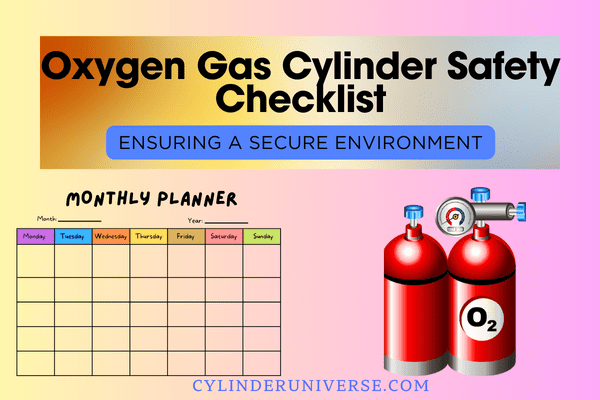Introduction
In various industries, the use of oxygen gas cylinders is indispensable for numerous applications, ranging from medical facilities to industrial settings. This article sheds light on the Oxygen Gas Cylinder Safety Checklist, a pivotal tool in ensuring a secure environment for handling these critical resources.

Understanding Oxygen Gas Cylinders
Before delving into safety measures, it’s crucial to grasp the fundamentals of oxygen gas cylinders. These cylinders typically contain compressed or liquid oxygen, playing a critical role in medical, industrial, and research applications. Understanding the properties and applications of these cylinders is foundational for implementing effective safety protocols.
Significance of Safety Measures
Emphasizing the significance of safety measures is paramount. Mishandling oxygen gas cylinders can lead to severe consequences, including fire hazards and health risks. Adhering to regulatory requirements is vital to ensuring a secure environment.
Creating Your Oxygen Gas Cylinder Safety Checklist
The core of a secure oxygen storage and usage system lies in a comprehensive safety checklist. This section outlines inspection procedures, proper storage guidelines, and essential considerations for maintaining a safe environment. The Oxygen Gas Cylinder Safety Checklist becomes a personalized guide for individuals and organizations.
Handling and Transporting Cylinders
Proper handling and transportation of oxygen cylinders are critical aspects of safety. This includes adopting suitable lifting techniques and securing cylinders during transportation to prevent accidents and leaks. The checklist should encompass these crucial aspects of cylinder handling.
Storage Considerations
The storage environment significantly influences the safety of oxygen gas cylinders. This section covers the importance of suitable storage conditions and the necessity of separating cylinders from incompatible materials to mitigate potential risks. Tailoring the checklist to specific storage requirements is key.
Emergency Preparedness
Being prepared for emergencies is a fundamental component of safety. Recognizing signs of trouble, implementing first aid measures, and having emergency response plans in place contribute to a swift and effective response. The checklist should incorporate these emergency preparedness measures.
Regular Maintenance and Inspection
Routine maintenance and inspection are essential for identifying and addressing potential issues before they escalate. Establishing a regular check routine ensures the ongoing safety of the oxygen storage system. The checklist serves as a guide for these routine checks.
Training and Awareness
Educating personnel on safety protocols and conducting regular drills enhance awareness and preparedness. This section emphasizes the role of training in preventing accidents and ensuring a safety-oriented culture. The checklist becomes a training resource for new personnel.
Regulatory Compliance
A brief overview of relevant regulations and the potential penalties for non-compliance underscores the legal aspect of maintaining a safe working environment. The checklist serves as a tool for ensuring regulatory compliance.
Common Mistakes to Avoid
Highlighting common mistakes, such as overlooking safety procedures and ignoring warning signs, serves as a cautionary reminder for individuals handling oxygen gas cylinders. The checklist becomes a reference to avoid these mistakes.
Case Studies
Real-life case studies provide practical insights into the consequences of safety lapses and the lessons learned from these incidents. The checklist can incorporate learnings from these case studies.
Benefits of a Comprehensive Safety Program
Beyond regulatory compliance, a comprehensive safety program benefits both employees and organizations. Prioritizing safety safeguards not only individual well-being but also protects property and equipment. The checklist becomes a tool for implementing and maintaining a robust safety program.
Continuous Improvement
The journey towards safety is ongoing. Seeking feedback, learning from experiences, and updating the safety checklist as needed ensures a continuously improving safety program. The checklist becomes a dynamic document that evolves with the organization’s safety needs.
Conclusion
In conclusion, the Oxygen Gas Cylinder Safety Checklist is a fundamental and personalized tool for ensuring a secure environment. By following the outlined measures in the checklist, individuals and organizations can create a secure environment, minimizing risks and prioritizing the well-being of everyone involved.
FAQs
- How often should oxygen gas cylinders undergo inspection?
- Regular inspections should be conducted at least once a month, with more thorough checks annually.
- Are there specific storage requirements for oxygen cylinders?
- Yes, oxygen cylinders should be stored in a well-ventilated area, away from flammable materials and heat sources.
- What should be included in an emergency response plan for oxygen cylinder incidents?
- An emergency response plan should include evacuation procedures, contact information for emergency services, and steps for administering first aid.
- Why is training essential for personnel handling oxygen cylinders?
- Training ensures that individuals are aware of safety protocols, emergency procedures, and proper handling techniques, reducing the risk of accidents.
- Can the safety checklist be customized based on specific industry requirements?
- Yes, the safety checklist should be tailored to the specific needs and regulations of the industry in which the oxygen cylinders are used.
1 thought on “Oxygen Gas Cylinder Safety Checklist: Ensuring a Secure Environment”